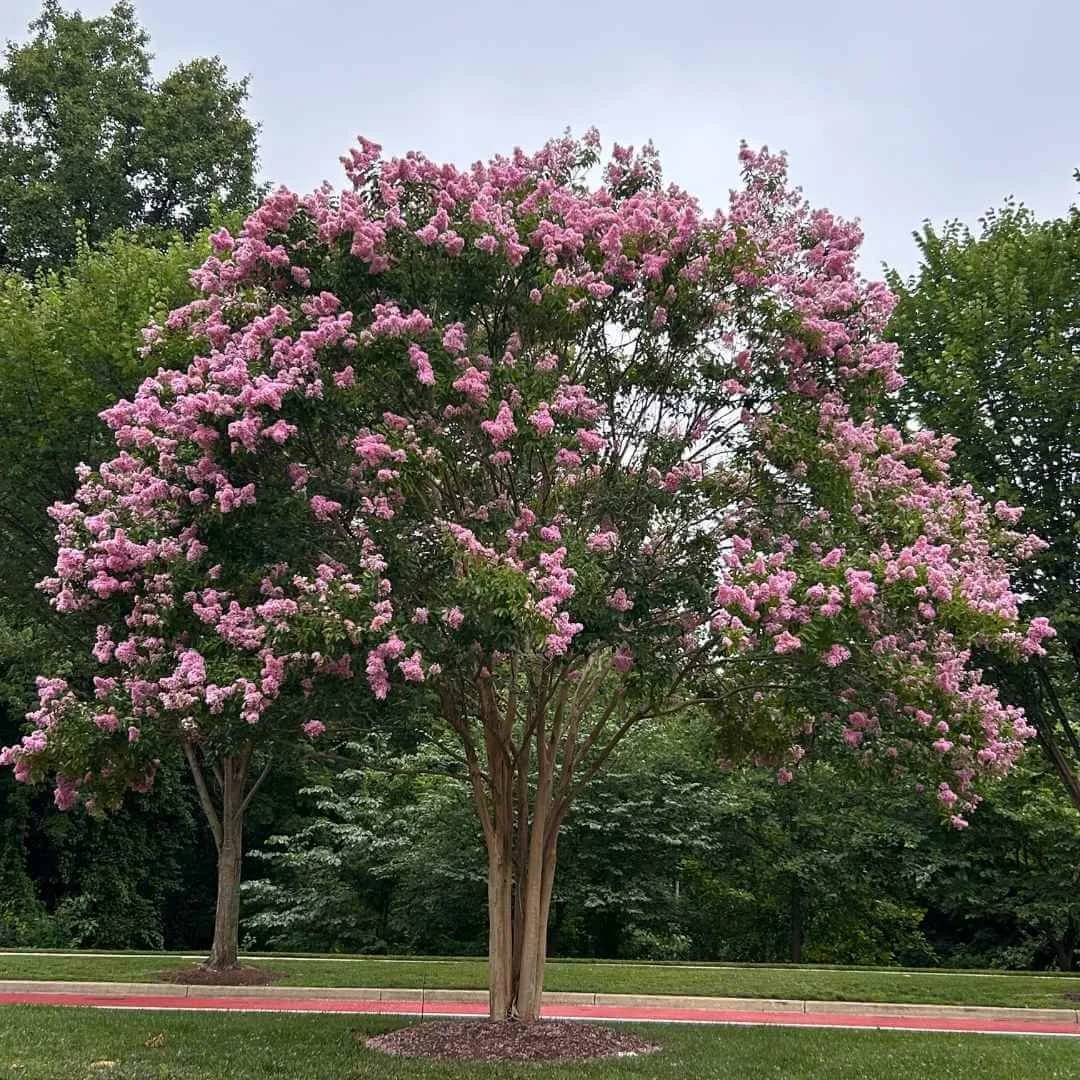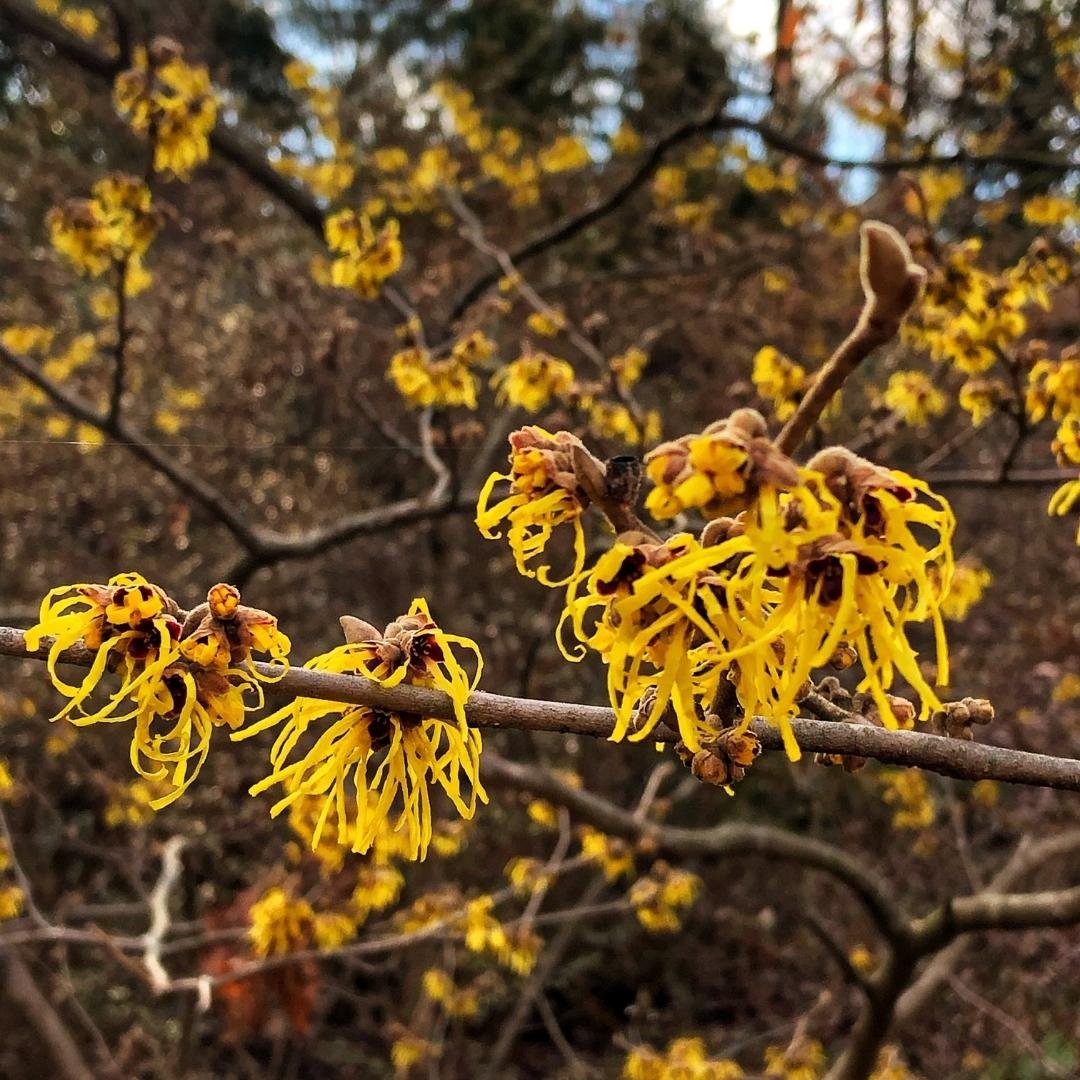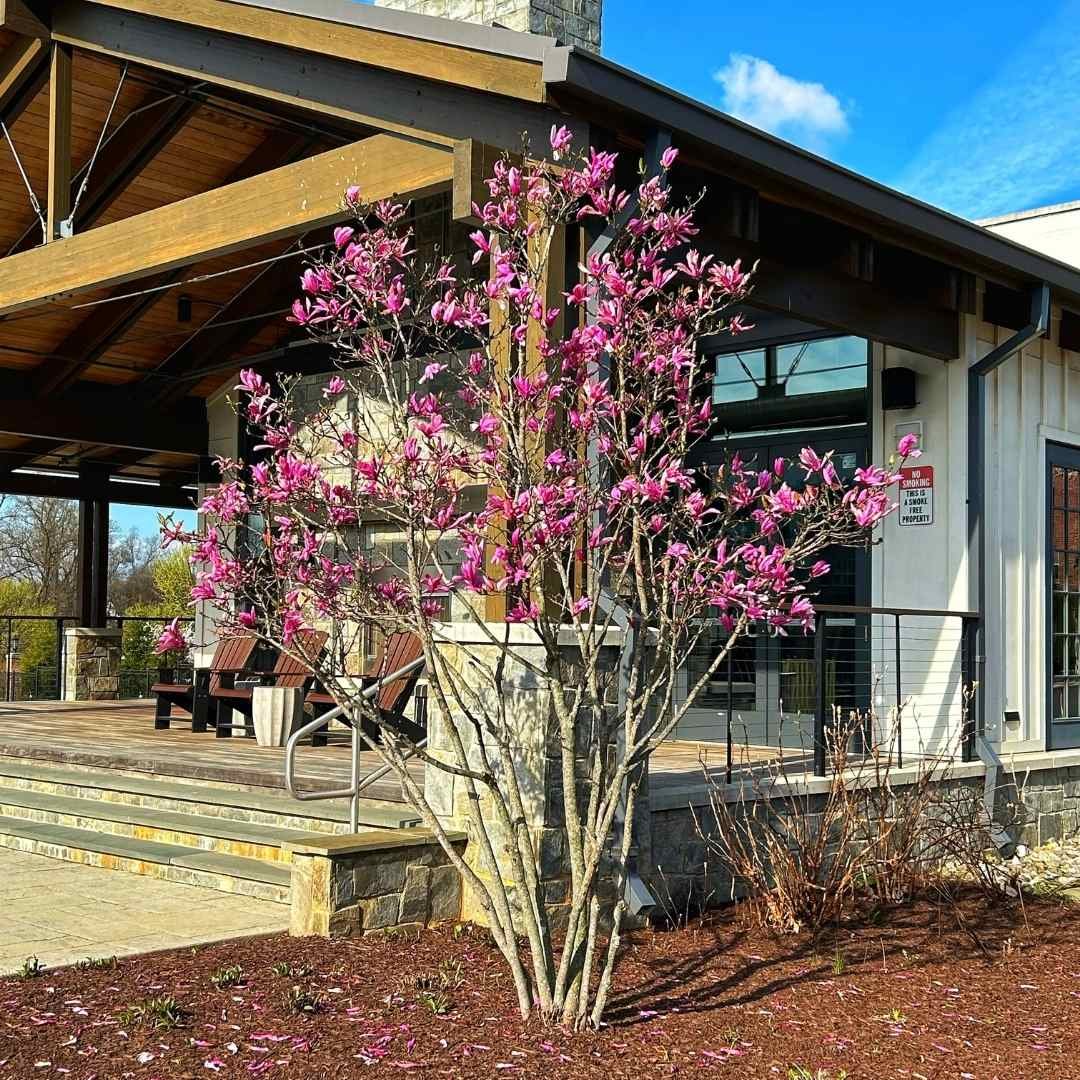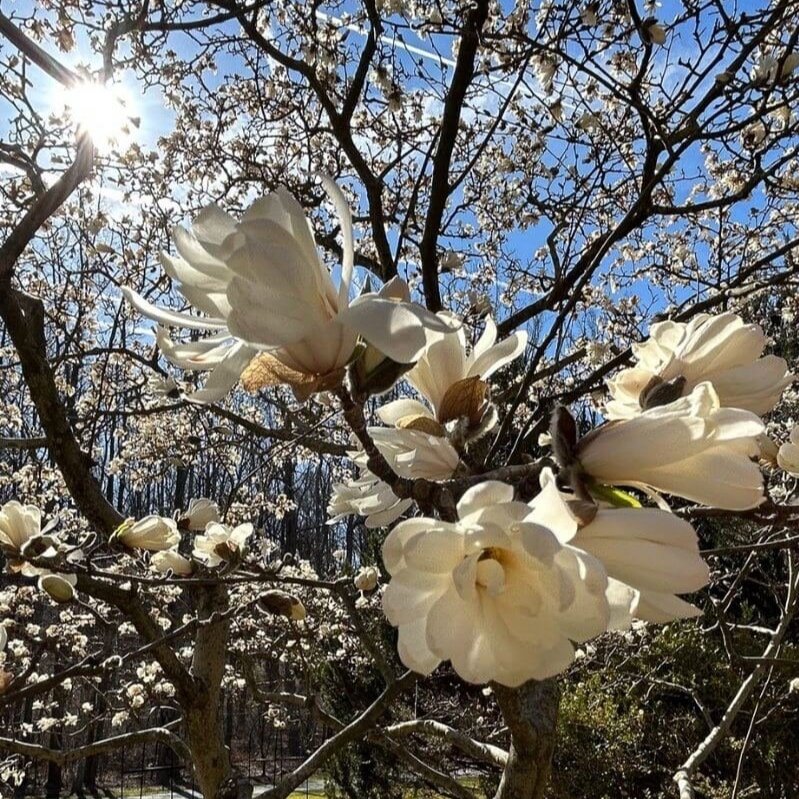Discover the Beauty of Yoshino Cherry Trees
Pink Spring Flowers
Learn how to plant and grow this iconic flowering cherry blossom tree.
The Yoshino cherry tree, scientifically known as Prunus × yedoensis, is a popular ornamental cherry tree prized for its beautiful, lightly fragrant spring blossoms.
This hybrid tree is believed to be a cross between Prunus speciosa (Oshima cherry) and Prunus subhirtella (weeping cherry), but the parentage remains unclear.
The Yoshino cherry is widely grown for its springtime show of delicate white to pink flowers.
This iconic tree is well known for gracing the Tidal Basin in Washington, D.C. where admirers celebrate the spring flowers with parades, festivals, poetry and art at the National Cherry Blossom Festival.
The fragrant spring flowers of the Yoshino cherry tree.
Yoshino cherry trees grow in full sun to part shade in zones 5-8. Full sun is best; flowering may be diminished in partial shade. Give this tree moist, well drained soil - it does not like wet feet or boggy soil, nor does it tolerate periods of drought.
Yoshino cherries are fast growing as young trees, growing 2 feet or more per year and slowing down in growth as the tree matures to a size of 30-40 feet tall and wide.
Yoshino cherry trees generally flower in late March to April, depending on the geographical location and weather. After flowering, small cherries called drupes ripen and eventually turn a shiny black, and are eagerly devoured by birds (these fruits are too bitter for humans to enjoy).
The dark green glossy leaves give way to shades of yellow, bronze and orange in fall, and the smooth glossy bark with prominent lenticels is a winter standout.
As with all ornamental cherries, Yoshino cherry trees tend to be relatively short-lived (15-20 years), and are susceptible to numerous insect pests and diseases.
How to Plant and Grow a Yoshino Cherry Tree
Planting and growing a Yoshino cherry tree involves several key steps to ensure successful establishment and development:
Location: Choose a planting site with full sun (6+ hours of sunlight per day) and moist, fertile, well-drained soil. Yoshino cherry trees will tolerate light shade as well as clay or sandy soil.
Planting Time: The best time of year to plant a Yoshino cherry tree is in spring or fall, giving the roots time to establish before the onset of extreme hot or cold weather. Water the tree deeply after planting.
Watering: Provide regular watering, especially during dry spells, to keep the soil consistently moist but not waterlogged. Water at the base of the tree to avoid wetting the foliage. To promote optimal growth and flowering, consistent moisture is best for a Yoshino cherry tree. For more information on watering, see “How to Water a Tree'“.
Mulching: Apply a layer of mulch around the base of the tree to help retain moisture, suppress weeds, and regulate soil temperature.
Fertilizing and Pruning: Cherry trees are light feeders, preferring a low-nitrogen fertilizer applied in early spring 2-3 weeks before blooming. Over-fertilization can cause disease and insect problems. Prune trees in the spring, when flowering has finished. To ensure the long-term health and resilience of your Yoshino cherry tree, it's advisable to establish a routine of hiring an arborist who can expertly handle fertilization and pruning, provide proactive care, and address potential issues promptly.
Be Vigilant: Yoshino cherry trees are subject to numerous problems caused by insects, disease, and weather extremes. Regularly inspect your tree, looking for changes in leaf color, spots, abnormalities, or signs of insect activity. A proactive approach to tree care can help to prevent problems from escalating, and will contribute to the long-term health and well-being of your tree.
The pure white flowers of the Cascade Snow™ cherry blossom tree.
Are Yoshino Cherry Trees Messy?
The Yoshino cherry is not considered to be a messy tree, especially when compared to some other types of fruit-bearing trees like crabapples and black cherries.
Yoshino cherries do have some characteristics that could be considered a nuisance, depending on your perspective:
Flower Petals: In the spring, Yoshino cherry trees produce beautiful, delicate blossoms that fall from the tree when flowering has finished, creating a lovely carpet of petals on the ground. Most people find this ephemeral display quite beautiful. The petals disappear quickly by disintegrating into the ground or getting blown away by wind and rain.
Fruit: The Yoshino cherry tree produces small fruits called drupes, which are eagerly gobbled up by the birds as soon as they ripen. On rare occasions, a few drupes may be left behind and will eventually drop to the ground, but the cleanup required is minimal.
Leaf Shedding: Like other deciduous trees, Yoshino cherries shed their leaves in the fall. During routine fall cleanups, gathering these leaves can be easily accomplished by using a rake or leaf blower.
Are Yoshino Cherry Trees Invasive?
The Yoshino cherry tree originates from Japan, where it has been cultivated and cherished for centuries. In the United States, it is a non-native tree but it is not considered invasive. It does not cause harm to the environment, humans, animals, nor the economy.
These trees are widely planted in urban and suburban landscapes, where they enhance the aesthetic appeal of parks, gardens, and streets without posing a threat to local ecosystems.
In fact, these trees contribute positively by sequestering carbon, providing food and shelter for various species of birds, and providing nectar for various species of butterflies and bees.
Yoshino cherry trees may be mistakenly perceived as invasive because their root system exhibits a tendency to spread extensively near the soil surface, sometimes causing hardscaping to heave and crack. It's important to consider this aspect when planning the placement of a Yoshino cherry tree, and avoid planting near current or future hardscaping locations.
How Big Does a Yoshino Cherry Tree Get?
Give a Yoshino cherry tree some space - it will eventually reach 30-40 feet in height and width. Young trees grow quickly are and will take on a wide rounded shape, making them an excellent shade tree.
Be sure to plant Yoshino cherries at least 20 feet away from buildings and other structures to accommodate their future spread. Young trees have a fast growth rate, adding 1-2 feet or more of height each year.
Consistent moisture is crucial for the optimal growth of a Yoshino cherry. Adequate water intake supports the tree's overall health and contributes to a faster growth rate.
During the growing season, it's essential to ensure that the soil around the Yoshino cherry tree remains consistently moist, avoiding both prolonged drought stress and waterlogging (are you in a drought? Check the U.S. Drought Monitor).
Yoshino cherry trees are often propagated through grafting. Grafting is a common horticultural practice in which a scion (a shoot or bud from the desirable tree) is attached to the rootstock of another tree. This allows growers to produce consistent and reliable trees, with desirable attributes like flower color or habit coming from the scion, combined with disease resistance, cold hardiness, and vigor from the rootstock.
In the case of Yoshino cherry trees, grafting is employed to maintain the genetic traits that make them popular ornamental trees, particularly their beautiful flowers. Because of this grafting practice, you may notice bulging and suckers forming from the graft union (the site where the scion and rootstock meet). Suckers are vigorous, rapidly growing stems that often appear in clusters at the base of the tree.
To manage suckers and keep a tidy appearance, it is common practice to prune them. Using sharp, clean pruning shears, cut the suckers back to the trunk. Ensure that your pruning tools are sharp enough to make a clean cut - ragged or torn cuts can be an entry point for disease.
Landscape Design Ideas for Yoshino Cherry Trees
Plant a Yoshino cherry as a stand-alone specimen tree on a front lawn. They can also be used as a street tree, or planted in a grouping in larger landscapes like parks and public areas for maximum impact.
Good planting companions include other spring flowering trees, such as the Kwanzan Cherry, Okame cherry , ‘Little Girl’ series magnolias, or a redbud, which starts to bloom just as the Yoshino fades.
Tall evergreen shrubs make excellent companions, particularly when positioned behind the Yoshino cherry tree to create a dense and dark backdrop that highlights the light and airy spring flowers.
Yoshino cherry trees have a shallow, spreading root system and should not be planted next to sidewalks, walkways, driveways, patios, or other hardscapes. Over time, the spreading tree roots can cause flagstones, bricks or concrete to shift, buckle and crack.
Avoid planting new Yoshino cherry trees close to existing hardscaped areas, and refrain from building new brick, stone, or concrete surfaces near older trees with substantial, widespread root systems.
Yoshino cherry trees planted next to dark evergreen hollies.
Yoshino Cherry Tree Cultivars
Afterglow (Prunus x yedoensis ‘Afterglow’): Bright pink flowers and leaves along with improved resistance to freeze damage. A more upright, spreading shape; grows 25 feet tall and wide.
Akebono (Prunus x yedoensis ‘Akebono’): A popular cultivar, slightly smaller than the straight species (25 feet tall and wide), with semi-double light pink flowers. Also known as ‘Daybreak’.
Cascade Snow™ (Prunus x yedoensis ‘Berry’ Cascade Snow™): Pure snowy white flowers and higher disease resistance. Grows to 25 feet high and wide.
Ivensii (Prunus x yedoensis ‘Ivensii’): Distinctive weeping form with branches cascading down to the ground. White flowers; grows 10-15 feet tall.
Pink Shell (Prunus x yedoensis ‘Pink Shell’): Large clusters of shell-pink flowers that fade to a lighter shade; grows 10-15 feet tall.
Shidare-Yoshino (Prunus x yedoensis ‘Shidare Yoshino’): Showy white flowers and a graceful, weeping form, growing to 20 feet tall.
Are Yoshino Cherry Trees Hard to Grow?
Yoshino cherry trees are generally easy to grow, thriving when planted in a suitable location with full sun and well-draining soil. However, it's crucial to distinguish between their ease of growth and their relatively short lifespan.
The Yoshino cherry tree is relatively short-lived, typically having a lifespan of 15 to 20 years. Factors influencing their lifespan include insect pests, disease susceptibility, and weather extremes. Despite their ephemeral nature, the intense beauty they bring during their blooming season makes them a cherished addition to gardens and landscapes.
To compensate for their shorter lifespan, ensure these trees receive optimal care. Consider regular checks by a certified arborist, who can inspect your tree and recommend pruning, fertilizing, and other proactive measures.
If you would prefer a longer-lived, lower-maintenance spring flowering tree, consider these alternatives to the Yoshino cherry tree:
Okame Cherry Tree (Prunus x incam): A flowering cherry tree with a slightly longer lifespan and greater tolerance for heat (learn more here).
Autumn Brilliance Serviceberry (Amelanchier x grandiflora ‘Autumn Brilliance’): Lacy white spring flowers, edible purple fruits, and brilliant red fall color. Grows 15-25 feet tall and wide.
The Little Girl Magnolias (Magnolia ‘Ann’, Magnolia ‘Jane’, and others): The Little Girl magnolias are a group of small, spring-flowering trees developed to avoid frost damage (learn more here).
Eastern Redbud (Cercis canadensis): A small deciduous tree with purple-pink springtime flowers and heart shaped leaves (learn more here).
White Fringetree (Chionanthus virginicus): A small, low-maintenance tree with soft white flowers blooming in mid-to late spring (learn more here).
When do Yoshino Cherry Trees Bloom?
Yoshino cherry trees are known for their delicate pink or white blossoms which emerge in early spring. In general, they tend to flower in March or April, depending on the geographical location. Blooms last on the trees for approximately 2-3 weeks.
Weather variations from year to year can influence the precise timing of cherry blossoms. Yoshino cherry trees bloom roughly 2 weeks before the Kwanzan cherry.
Yoshino cherry trees light up the early spring landscape.
Are Yoshino Cherry Trees Toxic to Dogs?
The leaves, stems, blossoms, and fruit pits of the Yoshino cherry tree are toxic to both people and animals, including dogs and horses. Wilted cherry leaves are particularly potent.
If you suspect your dog, horse, or other pet has ingested any part of a Yoshino cherry tree or is showing signs of illness, such as vomiting, difficulty breathing, or lethargy, it's crucial to contact your veterinarian immediately.
The Yoshino cherry fruit itself (without the pit) is non-toxic, but it has a bitter taste and is best left for the birds!
Learn more about which common indoor and outdoor plants are toxic to dogs here.
Find a Tree for Your Landscape:



























This stately, deciduous conifer thrives in zones 4-9.